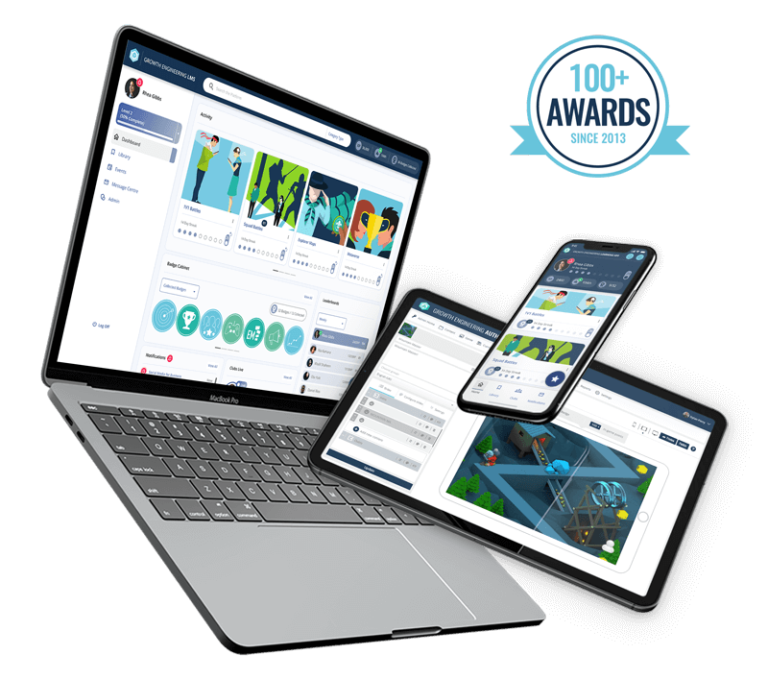No learning and development (L&D) leader will tell you that their job is an easy one. L&D trends come and go. But a lot of the challenges L&D leaders face are commonplace.
Learning leaders often have to overcome an unending stream of obstacles. These range from a lack of resources or stakeholder buy-in, to trying to transform stubborn learning cultures.
In addition, they often have to contend with factors beyond their control. COVID-19 anyone?
However, we’re here to help. In this article, we’ll take you through some of the common challenges L&D leaders have to tackle. Then we’ll give you some helpful advice on how to solve them!
8 Key Challenges That L&D Leaders Face
Let’s jump right in!
1. Proving the Value of a Learning Programme

Often, the challenges of being an L&D leader arises before a company has even implemented a learning programme. First, an L&D leader has to convince stakeholders that it’s worth the investment.
Unfortunately, the best online learning solutions don’t come cheap. For example, the current LMS market is worth a whopping $250 billion. Considering an LMS set-up fee can cost between $4,000 and $40,000, that makes a lot of sense.
And that’s before you add on license fees, labour costs, costs for instructional designers and so on.
If you’ve decided that online learning is the solution, it’s vital that you can prove that it will be valuable to your employees. There are a few steps commonly involved in this process:
- Do your homework: Stakeholders will have questions and you need to be ready with the answers. What will learners gain from the programme? How much will the solution you’ve picked out cost? A well prepared business case is a key foundation for success.
- Think about the long-term: Such an investment needs to be future-proof. Stakeholders won’t want to invest funds in a solution that will only last a few months.
- Share evidence of previous successes: There’s a lot of research out there about how effective eLearning can be. For example, did you know that eLearning takes around 40-60% less time to complete than traditional learning? Use lots of stats and evidence!
2. Proving the Value of a Learning Programme After the Fact
Once a learning programme has been implemented, you have to review its performance. 98% of L&D teams consider programme evaluation a priority. And for good reason.
You need to ensure your learning programme is effective and that your investment was worth it.
As such, you need to measure the return on investment (ROI). ROI will show you the positive financial outcome of your training programme, divided by the amount you’ve spent. See the formula below:
ROI can be written in a few ways, however best practice is to present it as a percentage or cost/benefit ratio.
Ultimately, what you want to achieve is a positive ROI. This means your investment has paid off. As you can imagine, a negative ROI indicates the opposite and action must be taken.
Furthermore, your LMS should generate reports based on elements like user engagement and course completion. For example, on Growth Engineering LMS, you have access to a bona fide reporting suite. You can filter results and export the data you need to prove your learners are loving their new platform.
Alternatively, it’s possible your learners just didn’t take to the programme. That brings us next on the list of our L&D challenges.
3. Fostering a Learning Culture
Have you ever wanted to complete a task but felt like you lacked the right support? Whether it’s knowing where to find information whilst you’re being onboarded in a new role, or needing somebody to hold a ladder for you. The principle remains the same.

You need to create the right environment for your learners to want to engage with their training content. They need to feel supported and empowered. This is what you’d call a learning culture.
However, this is much easier said than done. Currently, employees only dedicate an underwhelming 1% of their workweek to training. That’s a mere 24 minutes.
Cultivating a learning culture is a huge challenge for L&D leaders. Luckily, we’ve got a few tips that can help!
- Outline the benefits: Naturally, employees will be more motivated to engage with something if they can see the advantages.
The 2022 LinkedIn Workplace Learning Report found that employees are more motivated to learn if they can see how it will benefit their careers. Take care to provide clear guidance and signpost these benefits.
- Integrate eLearning organically: Change management is difficult. In fact, a shocking 60-70% of change management initiatives fail.
Therefore, it’s important for you to introduce eLearning early on in the recruitment and onboarding process for new employees. This helps them to understand that online learning is a big part of your culture. For existing employees, make it a gradual change with a lack of pressure.
- Keep it relevant: maintaining engagement is a difficult challenge for L&D leaders. In Gallup’s State of the Global Workforce 2022 report, they found that a mere 11% of employees are engaged at work. Yikes.
If employees feel like their eLearning courses are irrelevant, this engagement is likely to drop even further.
With an authoring tool, like Growth Engineering Authoring Tool, you can create courses packed with the right content for your learners. Additionally, on Growth Engineering LMS, you can create learning paths relevant to each specific role!
Creating a thriving learning culture can only do your organisation good. Indeed, Deloitte found that companies with strong learning cultures were a staggering 92% more likely to be innovators, as well as 17% more profitable than competitors.
4. Encouraging Learning in A Remote/Hybrid Set-Up
The whole world has recently undergone a huge transformation in the way we work. However, the shift in favour to remote working was already happening. In the US alone, the number of remote workers has grown nearly 400% within the last decade.
In addition, 74% of workers say that if they can work remotely, they’re more likely to stay at a company.

Consequently, as an L&D leader, one of the challenges you’ll face is encouraging employees to learn from home. It can be hard to connect with people when they can literally disconnect themselves from electronics to avoid training!
To counteract this, you should look to boost your knowledge of learning theory. There are a few learning theories that you can use to inform your methods.
For example, theories like Self-Determination Theory help learners to draw motivation from within themselves. Or, Behaviourism looks at how humans repeat certain behaviours based on whether they receive positive or negative reinforcement.
You could use game mechanics as positive reinforcement. For example, you could reward your learners with Badges and Experience Points when they complete their learning. As a result, they’ll be more motivated to come back.
Alternatively, take your learning initiatives mobile with Growth Engineering Learning App. This way you can make use of push notifications. This has been shown to increase user retention by 190%.
5. Mental Health and Wellbeing
In the last few years, L&D and HR’s responsibilities have increased. Now, they take on areas such as wellbeing and engagement alongside traditional tasks. This ever-broadening remit can be a one of the harder challenges for L&D leaders to tackle.
The rise of remote work has led to an increased feeling of isolation. Indeed, one in five remote workers have stated that they feel lonely. Additionally, in a survey of 2,000 workers, 67% said they found it difficult to remain connected to colleagues.

Furthermore, soft skills and emotional intelligence in the workplace have taken a hit. Since you don’t see your team as often, there are less opportunities to refine these important skills.
These factors combine to negatively impact the mental health of your workforce. 1 in 6.8 people are experiencing mental health problems in the workplace. What’s more, in a survey with over 1,500 respondents, 75% said they had experienced workplace burnout at their current job.
Luckily, we’ve got just the fix to overcome this L&D challenge!
By using social learning features on an LMS, you can simulate those interactions that remote workers are missing.
For example, 57.8% of employees cite a fear of judgement as the main reason they don’t seek help with their mental health. It’s up to you to create a space where they feel comfortable sharing their problems.
On our learning platform, you can create Clubs based on certain topics. You could create a Mental Health Club where people can discuss issues they’re going through. Or simply, Clubs based on hobbies where like-minded people can come together and build relationships.
In addition, you can use an authoring tool to create courses to develop soft skills and emotional intelligence. In a Yale study of over 15,000 employees, the most innovative industries had highly emotionally intelligent supervisors.
As such, it’s vital that you equip your workforce with the right tools to support each other.
6. Gaining Feedback

Did you know that companies that consistently act on employee feedback experience 14.9% lower turnover rates? To add to this, employees are 4.6x more likely to perform better if they feel their voice has been heard.
In any organisation, gaining feedback is essential. Feedback on products, processes and in this case on your learning initiative. Unfortunately, soliciting feedback can be a one of the worst challenges for even the most hardened L&D leader.
You’ve invested financial and labour resources into setting up your online learning solution. Now you need to find out from those using it if it was worth it. There are a few ways to go about this.
You could:
- Do it at the end of an online classroom session: This allows for more conversational feedback, which some learners may prefer.
- Foster a discussion: Social feeds can be great for discussion topics. Using an admin profile, you’re able to post questions about the platform. Then learners can comment on these posts with their feedback.
- Create a survey: On our platform, you can create surveys and send them out to learners for feedback. This is great for collecting answers in a controlled environment!
Feedback is also essential to an employee’s growth and progression in their learning. After all, why would they want to engage with a platform that they’ve expressed they don’t enjoy?
Of course, once you’ve collected your feedback, it’s important that you are attentive. You’ll need to implement what you can and provide explanations for everything that you can’t.
7. Finding the Right Fit

Our last L&D challenge focuses on finding the right fit for your organisation.
There are over 800 LMS vendors on the market. All of them are different in some way. For example, some are open-source whilst others are cloud-based. The investment required will vary depending on your needs.
Once you’ve selected the right platform, you’ll need to establish where it fits within your software stack. Will it stand alone, or will you look to integrate it with other solutions to automate processes and drive efficiency?
You’ll need to do quite a bit of research beforehand. Find out how your other systems operate, like your HR system. From there, you’ll know what LMS will work best with them. That way you’ll be able to automate the user provisioning process, saving bucketloads of time!
For example, Growth Engineering LMS is able to integrate with a huge number of other systems. This includes HR software like BambooHR, virtual classrooms like Zoom and more.
You can even share Badges you’ve recently earned directly to social media platforms!
You should also take advantage of the resources available to you. Many companies offer free demos of their solutions. This way you can get a better understanding of the platform and ask questions directly. They’re also likely to have pricing guides and case studies available on their website.
Last but not least, ask stakeholders for their input. Finding out what they think the platform needs or if there’s any leeway on the budget allocated can be a big help.
8. Responding at the Speed of Need

Successful L&D teams need to be responsive. That means you need to be a responsive leader, ready to act when the moment calls for it.
As an L&D leader, you need to be ready with new content and learning experiences whenever there’s a change in the business. This includes products, processes, regulations and so on.
This was particularly challenging during the height of the pandemic when it felt like there was a new regulation every day!
To solve this challenge, you need to make sure your learning culture is agile. Tips for this include:
- Make learning a two-way street: Ask your employees to keep you informed on what they need and any industry changes. On the flip side, your L&D team needs to be ready to act to help fill the support void.
- Take advantage of microlearning: Microlearning means converting longer content into bite-sized chunks.
This means it won’t take you nearly as long to create learning content. In fact, microlearning has been shown to cut development costs by 50% and increase development speed by 300%!
Furthermore, the time it takes for learners to consume content is reduced. As a result, microlearning can increase engagement by 50%.
- Rely on software: The software you have available will make or break your response times. You need to make sure it can handle sudden requests and help you to move at the speed of need.
For example, Growth Engineering Authoring Tool is a whiz at creating courses in a flash. In response to the rapid guideline changes caused by the pandemic, one of our Fortune 500 clients used it to create ‘Back to Store’ safety guidelines. They saw stunning completion rates (81%) across all units!
Final Word
Being an L&D leader isn’t easy. But it is rewarding.
We’ve covered a lot of the challenges that L&D leaders will face at some point. Whether it’s to do with your employees’ well being, driving cultural change or proving your training initiative was worth the investment.
No two challenges an L&D leader will experience are exactly the same. Much depends on the nature of your organisation or the resources you have at hand.
However, even the hardest challenges have a solution. If you follow the steps we’ve provided, you’ll overcome these obstacles and establish your leadership bona fides. Good luck!
Are you struggling with an L&D challenge? Would you like some expert advice? Get in contact with us today!
Unlimited Learner Engagement on
The Impact Suite









